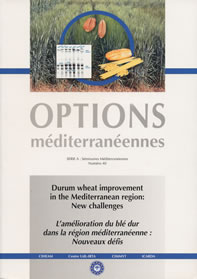| Article précédent | p. 333-339 | Article suivant |
Combination of mechanisms of resistance to rust fungi as a strategy to increase durability
It is unknown which criteria to use to decide whether a resistance is durable or not. We present some examples where resistance to cereal rusts that proved to be durable is of complex inheritance, and also others where durability is due to particular single genes that cause relatively small effects on the pathogen development, and yet seem to be race-non-specific and not based on hypersensitivity. Their effect can be greatly enhanced if they occur in combination with other, even when these maybe race-specific, resistance genes. Combinations of different resistance mechanisms seem to be of great value to increase durability of resistance. It is generally agreed that the use of cultivars with single-gene race-specific resistance should be avoided, but such genes could still be of great help in enhancing and/or protecting durability. An alternative to the development of individual cultivars with long-lasting resistance might be the use of genetic diversity for resistance and diversity in its strategic deployment, and may include combining of race-specific with non-specific resistance.
- [ Afficher ]
- [ Télécharger ]
- [ Exporter la citation ]
Vous pouvez télécharger la citation au format :
- [ Imprimer ]
-
Mots-clés
BLE, PUCCINIA GRAMINIS, PUCCINIA RECONDITA, PUCCINIA STRIIFORMIS, RESISTANCE AUX MALADIES, ROUILLE, TISSU VEGETALCiter cet article
Rubiales D., Niks R.E. Combination of mechanisms of resistance to rust fungi as a strategy to increase durability. In : Royo C. (ed.), Nachit M. (ed.), Di Fonzo N. (ed.), Araus J.L. (ed.). Durum wheat improvement in the Mediterranean region: New challenges . Zaragoza : CIHEAM, 2000. p. 333-339. (Options Méditerranéennes : Série A. Séminaires Méditerranéens; n. 40). Seminar on Durum Wheat Improvement in the Mediterranean Region: New Challenges, 2000/04/12-14, Zaragoza (Spain). http://om.ciheam.org/om/pdf/a40/00600056.pdf



